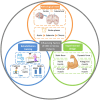Influencing factors of corticomuscular coherence in stroke patients
- PMID: 38562230
- PMCID: PMC10982423
- DOI: 10.3389/fnhum.2024.1354332
Influencing factors of corticomuscular coherence in stroke patients
Abstract
Stroke, also known as cerebrovascular accident, is an acute cerebrovascular disease with a high incidence, disability rate, and mortality. It can disrupt the interaction between the cerebral cortex and external muscles. Corticomuscular coherence (CMC) is a common and useful method for studying how the cerebral cortex controls muscle activity. CMC can expose functional connections between the cortex and muscle, reflecting the information flow in the motor system. Afferent feedback related to CMC can reveal these functional connections. This paper aims to investigate the factors influencing CMC in stroke patients and provide a comprehensive summary and analysis of the current research in this area. This paper begins by discussing the impact of stroke and the significance of CMC in stroke patients. It then proceeds to elaborate on the mechanism of CMC and its defining formula. Next, the impacts of various factors on CMC in stroke patients were discussed individually. Lastly, this paper addresses current challenges and future prospects for CMC.
Keywords: EEG; corticomuscular coherence; influencing factors; sEMG; stroke.
Copyright © 2024 Gao, Lv, Ran, Wang, Xia, Wang, Qiu, Wei, Shao, Zhao, Zhang, Zhou and Yu.
Conflict of interest statement
The authors declare that the research was conducted in the absence of any commercial or financial relationships that could be construed as a potential conflict of interest.
Figures
Similar articles
-
Corticomuscular Coherence and Its Applications: A Review.Front Hum Neurosci. 2019 Mar 20;13:100. doi: 10.3389/fnhum.2019.00100. eCollection 2019. Front Hum Neurosci. 2019. PMID: 30949041 Free PMC article. Review.
-
Using Corticomuscular Coherence to Reflect Function Recovery of Paretic Upper Limb after Stroke: A Case Study.Front Neurol. 2018 Jan 10;8:728. doi: 10.3389/fneur.2017.00728. eCollection 2017. Front Neurol. 2018. PMID: 29375467 Free PMC article.
-
Corticomuscular coherence in acute and chronic stroke.Clin Neurophysiol. 2014 Jun;125(6):1182-91. doi: 10.1016/j.clinph.2013.11.006. Epub 2013 Nov 16. Clin Neurophysiol. 2014. PMID: 24315544 Clinical Trial.
-
Pattern Reorganization of Corticomuscular Connection with the Tactile Stimulation.Ann Biomed Eng. 2020 Feb;48(2):834-847. doi: 10.1007/s10439-019-02421-y. Epub 2019 Dec 6. Ann Biomed Eng. 2020. PMID: 31811473 Clinical Trial.
-
Lower-Limb Motor Assessment With Corticomuscular Coherence of Multiple Muscles During Ankle Dorsiflexion After Stroke.IEEE Trans Neural Syst Rehabil Eng. 2023;31:160-168. doi: 10.1109/TNSRE.2022.3217571. Epub 2023 Jan 30. IEEE Trans Neural Syst Rehabil Eng. 2023. PMID: 36288216
Cited by
-
Neural control meets biomechanics in the motor assessment of neurological disorders: a narrative review.Front Neural Circuits. 2025 Jun 27;19:1608328. doi: 10.3389/fncir.2025.1608328. eCollection 2025. Front Neural Circuits. 2025. PMID: 40657418 Free PMC article. Review.
-
Optimising Paediatric Brain Mapping with Single-Pulse Transcranial Magnetic Stimulation: A New Protocol and Insights.Ann Neurosci. 2025 Jun 12:09727531251340157. doi: 10.1177/09727531251340157. Online ahead of print. Ann Neurosci. 2025. PMID: 40520438 Free PMC article.
-
Beta-Band Cortico-Muscular Phase Coherence in Hemiparetic Stroke.Biomed Signal Process Control. 2024 Nov;97:106719. doi: 10.1016/j.bspc.2024.106719. Epub 2024 Aug 7. Biomed Signal Process Control. 2024. PMID: 39493553
-
Case report: Exploring cortico-muscular coherence during Mirror visual feedback for deafferentation pain: a proof-of-concept study.Front Hum Neurosci. 2025 Feb 24;19:1525680. doi: 10.3389/fnhum.2025.1525680. eCollection 2025. Front Hum Neurosci. 2025. PMID: 40065798 Free PMC article.
References
Publication types
LinkOut - more resources
Full Text Sources



